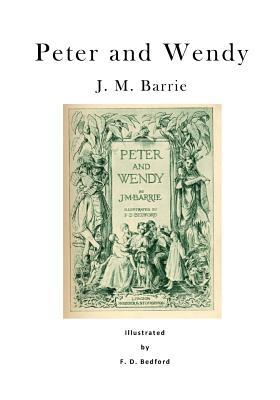Peter and Wendy
J. M. Barrie
Illustrated by F. D. Bedford
Peter Pan; or, the Boy Who Wouldn't Grow Up or Peter and Wendy is J. M. Barrie's most famous work, in the form of a 1904 play and a 1911 novel. Both versions tell the story of Peter Pan, a mischievous little boy who can fly, and his adventures on the island of Neverland with Wendy Darling and her brothers, the fairy Tinker Bell, the Lost Boys, and the pirate Captain Hook. The play and novel were inspired by Barrie's friendship with the Llewelyn Davies family. Barrie continued to revise the play for years after its debut until publication of the play script in 1928.
Although the character appeared previously in Barrie's book The Little White Bird, the play and its novelisation contain the story of Peter Pan mythos that is best known. The two versions differ in some details of the story, but have much in common. In both versions Peter makes night-time calls on the Darlings' house in Bloomsbury, listening in on Mrs. Mary Darling's bedtime stories by the open window. One night Peter is spotted and, while trying to escape, he loses his shadow. On returning to claim it, Peter wakes Mary's daughter, Wendy Darling. Wendy succeeds in re-attaching his shadow to him, and Peter learns that she knows lots of bedtime stories. He invites her to Neverland to be a mother to his gang, the Lost Boys, children who were lost in Kensington Gardens. Wendy agrees, and her brothers John and Michael go along.
Their magical flight to Neverland is followed by many adventures. The children are blown out of the air by a cannon and Wendy is nearly killed by the Lost Boy Tootles. Peter and the Lost Boys build a little house for Wendy to live in while she recuperates (a structure that, to this day, is called a Wendy House.) Soon John and Michael adopt the ways of the Lost Boys.
Peter welcomes Wendy to his underground home, and she immediately assumes the role of mother figure. Peter takes the Darlings on several adventures, the first truly dangerous one occurring at Mermaids' Lagoon. At Mermaids' Lagoon, Peter and the Lost Boys save the princess Tiger Lily and become involved in a battle with the pirates, including the evil Captain Hook. Peter is wounded when Hook claws him. He believes he will die, stranded on a rock when the tide is rising, but he views death as "an awfully big adventure." Luckily, a bird allows him to use her nest as a boat, and Peter sails home.
The play debuted in London on 27 December 1904 with Nina Boucicault, daughter of playwright Dion Boucicault, in the title role. A Broadway production was mounted in 1905 starring Maude Adams. It was later revived with such actresses as Marilyn Miller and Eva Le Gallienne. The play has since been adapted as a pantomime, stage musical, a television special, and several films, including a 1924 silent film, Disney's 1953 animated full-length feature film, and a 2003 live action production. The play is now rarely performed in its original form on stage in the United Kingdom, whereas pantomime adaptations are frequently staged around Christmas. In the U.S., the original version has also been supplanted in popularity by the 1954 musical version, which became popular on television.
The novel was first published in 1911 by Hodder & Stoughton in the United Kingdom and Charles Scribner's Sons in the United States. The original book contains a frontispiece and 11 half-tone plates by artist F. D. Bedford (whose illustrations are still under copyright in the EU). The novel was first abridged by May Byron in 1915, with Barrie's permission, and published under the title Peter Pan and Wendy, the first time this form was used. This version was later illustrated by Mabel Lucie Attwell in 1921. In 1929, Barrie gave the copyright of the Peter Pan works to Great Ormond Street Hospital, a children's hospital in London.
